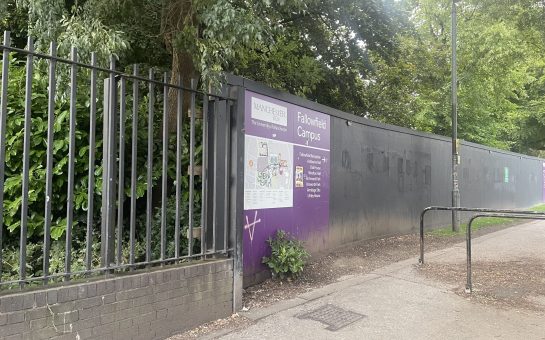Discussing nano-materials may not be everyone’s choice of relaxed dinner conversation, but for two Manchester University students, some Italian home cooking was the inspiration for a breakthrough in the hunt for a cure for cancer.
PhD students Andrea Francesco Verre and Marco Fiorillo were dining together one night in July when they began discussing the biomedical application of graphene.
Although they did not know it at the time, the students had kick-started a scientific breakthrough – the discovery that graphene oxide neutralises cancer stem cells – which has the potential to save lives taken by recurrent cancer.
Marco told MM: “We were making some jokes about sticking graphene to cells like tomato sauce and mincemeat sticks to pasta.”
A few evenings later the duo met again to study the existing literature on graphene oxide interaction and seriously consider the possibility of starting some research into the uncharted field.
Andrea said: “Me and Marco thought that graphene oxide had already been previously tested as a material for tissue engineering application to manipulate stem cell behaviour but no one studied the interaction between cancer stem cells and graphene oxide and we decided that it would be interesting to start working on this.”
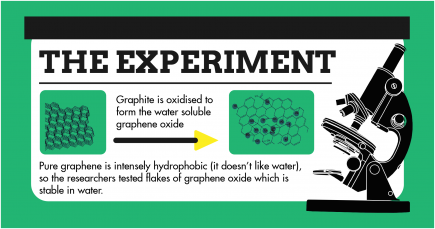
The science students then approached their supervisors, Director of the Manchester Centre for Cellular Metabolism Professor Michael Lisanti and Lecturer in Nanomaterials Dr Aravind Vijayaraghavan.
Their department heads, who later collaborated as the lead researchers in the project, talked to MM about the discovery and its potential to revolutionise the treatment of the often fatal disease.
Professor Lisanti said: “I had been thinking about doing something on graphene but I didn’t really have the connection.
“They greased the wheels of progress by looking for Italian food in Manchester. It’s all about the students in the end.”
The two academics had never come across each other before their PhD students introduced them, but after meeting they thought it would be ‘fun’ to test graphene on cancer stem cells.
Professor Lisanti said that although graphene has been shown to be non-toxic for normal cells they ‘had no preconceived idea that it would actually work’.
However they soon found that graphene oxide flakes prevented cancer stem cells from forming tumour spheres.
Instead the flakes forced the harmful cells to change into non-cancer stem cells, effectively neutralising the root of the cancer selectively whilst being harmless to healthy cells.
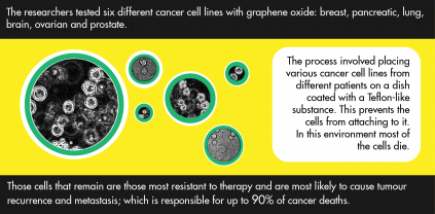
Despite being entirely new research, the testing process was relatively straightforward.
Describing the experiment, Dr Vijayaraghavan told MM: “We noticed that as you add more and more graphene oxide (GO) [to the cancer cells] you have a lesser number of tumour spheres forming.
“And when you reached a certain threshold, at about 50 micrograms per millilitre, at that concentration you are not having any tumour spheres forming.”
Initially, it seemed that the GO killed the cancer stem cells, but on closer investigation they observed that the process taking place was differentiation – by which a less specialised cell develops to become a more specialised cell type.
Professor Lisanti added that this was different from most ‘harsh’ chemo-therapeutics which are toxic to cells, such as chemotherapy.
“There is already a precedent that graphene could be used as a differentiating agent but no one thought about it in the context of cancer. And we did it by accident,” he said.
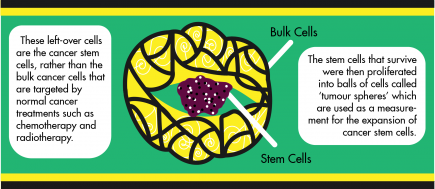
The experimental process gave very similar results across all six different cancers and so far appears to be a generic way to attack cancer stem cells, regardless of the cancer type.
However the researchers say the compound alone would not replace conventional cancer therapies, since the bulk cancer cells also need to be killed or neutralised so theoretically GO could be used in conjunction with chemotherapy or radiotherapy.
Dr Vijayaraghavan said: “We hope the graphene will make sure the cancer either doesn’t spread or doesn’t come back after the treatment.
“Usually if a cancer comes back the chances of a second round of treatment being successful are very, very small because your body is already seriously compromised from the previous round of treatment.
“Most of the cancer deaths come because of recurrence of the cancer so that’s what we hope to stop.”
But the reality of graphene oxide as a cancer cure is still well in the future.
Clinical trials could not begin for at least another three years so even if the treatment passes every step of the stringent trial period it remains at least ten years away from mass application.
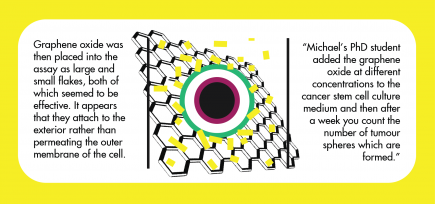
Professor Lisanti said: “Still no one has ever put graphene into humans. Everybody’s chicken.
“But they’ve put it into mice and it does have anti-tumour activity. We don’t know if it does anything else.”
The possibilities of graphene as a wonder material appear endless, although so far its practical application has been limited.
Sculptor Cornelia Parker used a graphene moisture-sensor – activated by the breath of a physicist – to set off a firework display which returned iron meteorite into the Manchester sky as part of the re-opening celebrations for the Whitworth Art Gallery in February.
However Dr Vijayaraghavan described this as a ‘gimmick’ use of graphene.
He added: “[Graphene] is a wonder material because of its properties, not because of its applications. Translating properties into applications takes time.
“It’s the first two-dimensional material. It’s still the strongest and the lightest and the thinnest and the best conductor of electricity. There is no other material which can compare to it.
“Whether or not we can harness that to something useful is an engineering and economic challenge.
“It would be great if we could realise the potential of graphene, but from a scientific perspective, it’s still a wonder material.”
Graphene was first isolated and explored in 2004 by professors Sir Andre Geim and Sir Kostya Novoselov at the University of Manchester, and demonstrating the amazing properties of graphene won them the Nobel Prize for Physics in 2010.
The university’s National Graphene Institute is due to open later this year.
Image courtesy of Geir Mogen, NTNU, with thanks.
